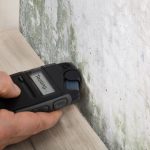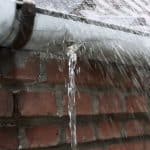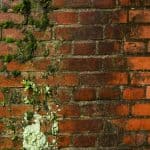Penetrating Damp
What can be done to stop penetrating damp entering walls?
What is penetrating damp? Simply put, it refers to the fact that water, through one cause or another, is entering deep inside the fabric of a wall, sometimes appearing inside. This can appear as spots of damp on a wall such as a bedroom or landing or it may appear, around window frames and lintels as it trickles down the wall, it can run along horizontal timber beams, etc.
Don’t be fooled into thinking the area outside the wall adjacent to the internal damp patch is where the damp is entering, as we all know water will find all sorts of routes as it runs downwards.
Penetrating damp through a wall can be a constant problem or can happen occasionally, depending on the direction of the weather (horizontal wind-driven rain).
Penetrating damp on walls can happen to all types of wall finishes, such as brick, stone, rendered or pebble-dashed houses.
Solid walls can be more susceptible to wind-driven rain & penetrating damp
Damp in solid walls can occur, especially if they have been rendered or re-pointed in inappropriate or poor-quality concrete finishes (sand and cement).
Orientation and the geographical location of the house all have a lot to do with the chances of wind-driven rain penetrating the walls.
This is why in the old days, solid stone walls were built about 400-500mm +. The thickness of the walls allows the rain to be soaked up without entering the internal sections.
The moisture is then evaporated away from the wall by the sun and wind.
Putting concrete render, spray textured paint or cement pointing on this type of wall can completely upset this balance and cause major damp problems.
For more information about rendering old solid-built walls
Houses featuring Cavity Walls started to be built around 1919
The chances of the damp entering cavity walls are normally reduced as the cavity inner leaf cannot be bridged, hence the reason they built walls with cavity voids. Walls were not insulated before energy increases caused by the Gulf crisis, etc. This is when building regulations were markedly changed, making insulation of walls a requirement.
Damp can enter the inner cavity leaf. If bridging occurs, sometimes this happens when retrospective cavity wall insulation has been fitted, or when the wall ties are contaminated with mortar, or the cavity is narrow and compacted with debris, etc.
Energy performance certificates (EPC) surveys will trigger a recommendation for cavity wall insulation ( if it has not been done already, that is, most houses have been retro-treated with blown-in mineral wool) Private landlord’s Minimum Energy Efficiency Standards rating (at the time of writing, E)
Filling a wall cavity can be very beneficial for energy efficiency reasons and can save a lot of money in heating bills, but before a wall is drilled and glass wool is blown in, the walls should be inspected and checked to make sure they will not allow penetrating water to enter.
Things such as pointing, rendering, and the porosity of the masonry exposure to wind-driven rain should all be inspected.
All too often, we see walls that have a defective render, badly eroded brickwork (spalled), defective pointing, etc, that should have been noted and corrected before being insulated.
If damp occurs, then it is up to the homeowner (hopefully through an insurance scheme provider such as
CIGA ) to get the insulation material removed.
Once the insulation material has been removed from the cavity, the exterior wall finish should be inspected and, if required, renewed or repaired
If a poor quality render has been applied or the incorrect type of render, then it can be susceptible to cracking and untimely failure.
Defective, damaged or cracked render can also allow penetrating damp to get inside a home
Cracks in render mean the writing is on the wall (pardon the pun), the render will eventually fail and cause damp. Even hairline cracks can allow copious amounts of water to get inside the render and the wall.
During winter months, when temperatures plummet, freeze-thaw damage occurs. Basically, any water trapped between the wall and the render freezes it, then expands and creates bigger damaged areas and cracks, allowing more water to get inside.
Render can appear to be sound and solid, so don’t just look for visible signs of defects; you need to hammer test the render to identify any blown or hollow sections
Even the smallest drip from a leaking gutter can produce gallons of water over time, the constant descending damp can cause some pretty serious damage to the wall of the building.
The next time it rains heavily, we suggest you get your coat on and get your umbrella ready, go take a look around your house to see how the roofline is coping. If water is sloshing down the walls, get the problem fixed, it could be something as simple as blocked guttering or a leaking joint.
-

-
Damp meter
-

-
Defective rain water goods (RWG)
-

-
descending damp
Penetrating damp is often confused with rising damp. Rising damp usually affects the lower height of a wall and stops at a height of around 900-1000mm, penetrating damp usually occurs higher up the wall and can get worse with certain weather conditions, such as driving rain from a S/W direction.




